ITECH1100: Wearable Technology's Impact on Real Estate Industry
VerifiedAdded on 2023/06/04
|9
|2193
|110
Report
AI Summary
This report examines the transformative impact of wearable technology on the real estate industry. It explores how devices like smart glasses, smartwatches, and virtual reality are revolutionizing the way real estate agents operate and how potential buyers shop for properties. The report discusses specific applications such as smart glasses for online field work, smartwatches for communication and data access, and virtual reality for lifestyle home builders. It also addresses potential constraints in adoption, including security, increased crime, privacy, and misuse of devices. The report outlines process components like smart glasses, smartwatches, sci-fi style devices, and iBeacons, and describes changes brought about by the technology, such as virtual home previews and enhanced communication capabilities. The report references various sources to support its claims, providing a comprehensive overview of wearable technology's role in reshaping the real estate landscape.
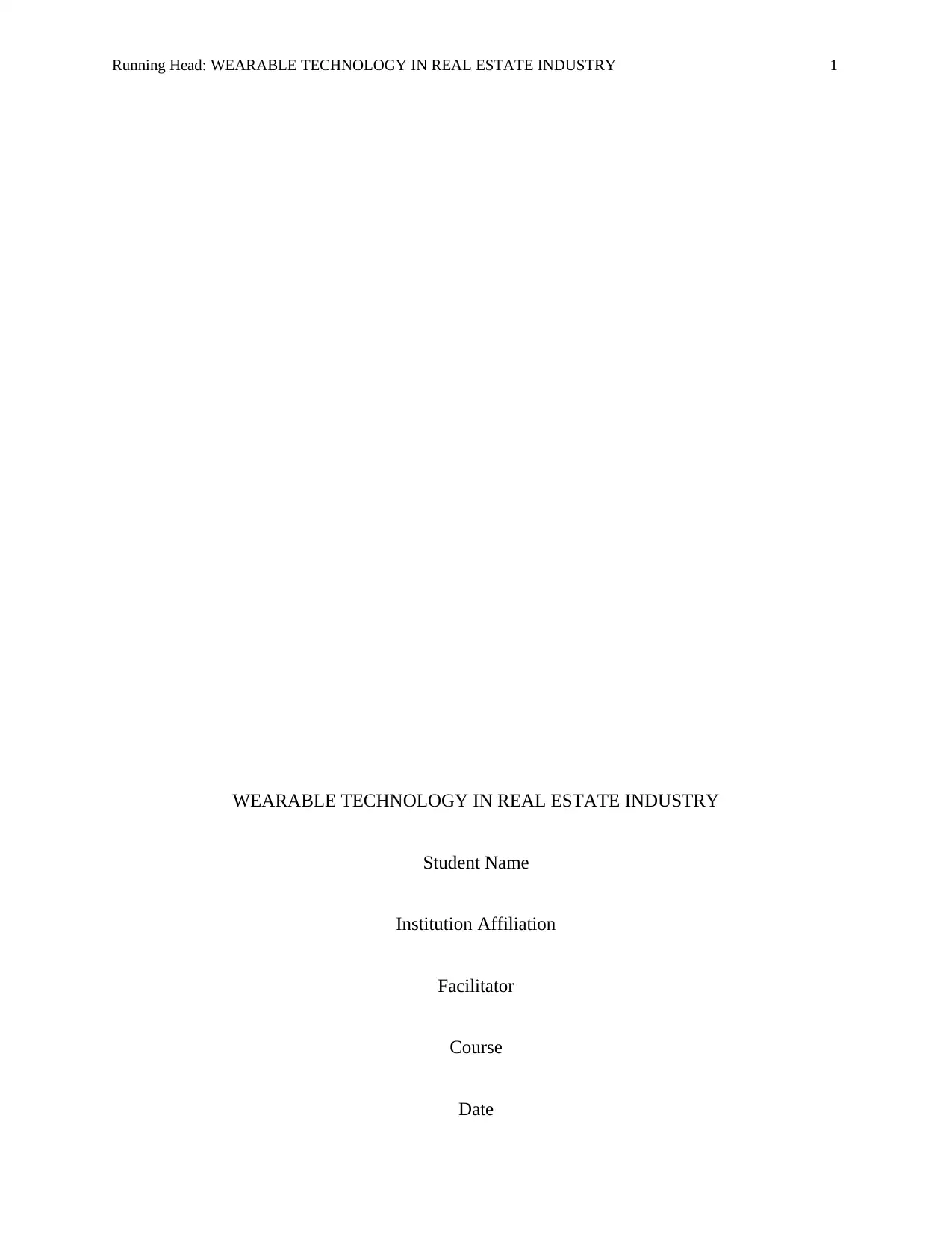
Running Head: WEARABLE TECHNOLOGY IN REAL ESTATE INDUSTRY 1
WEARABLE TECHNOLOGY IN REAL ESTATE INDUSTRY
Student Name
Institution Affiliation
Facilitator
Course
Date
WEARABLE TECHNOLOGY IN REAL ESTATE INDUSTRY
Student Name
Institution Affiliation
Facilitator
Course
Date
Paraphrase This Document
Need a fresh take? Get an instant paraphrase of this document with our AI Paraphraser
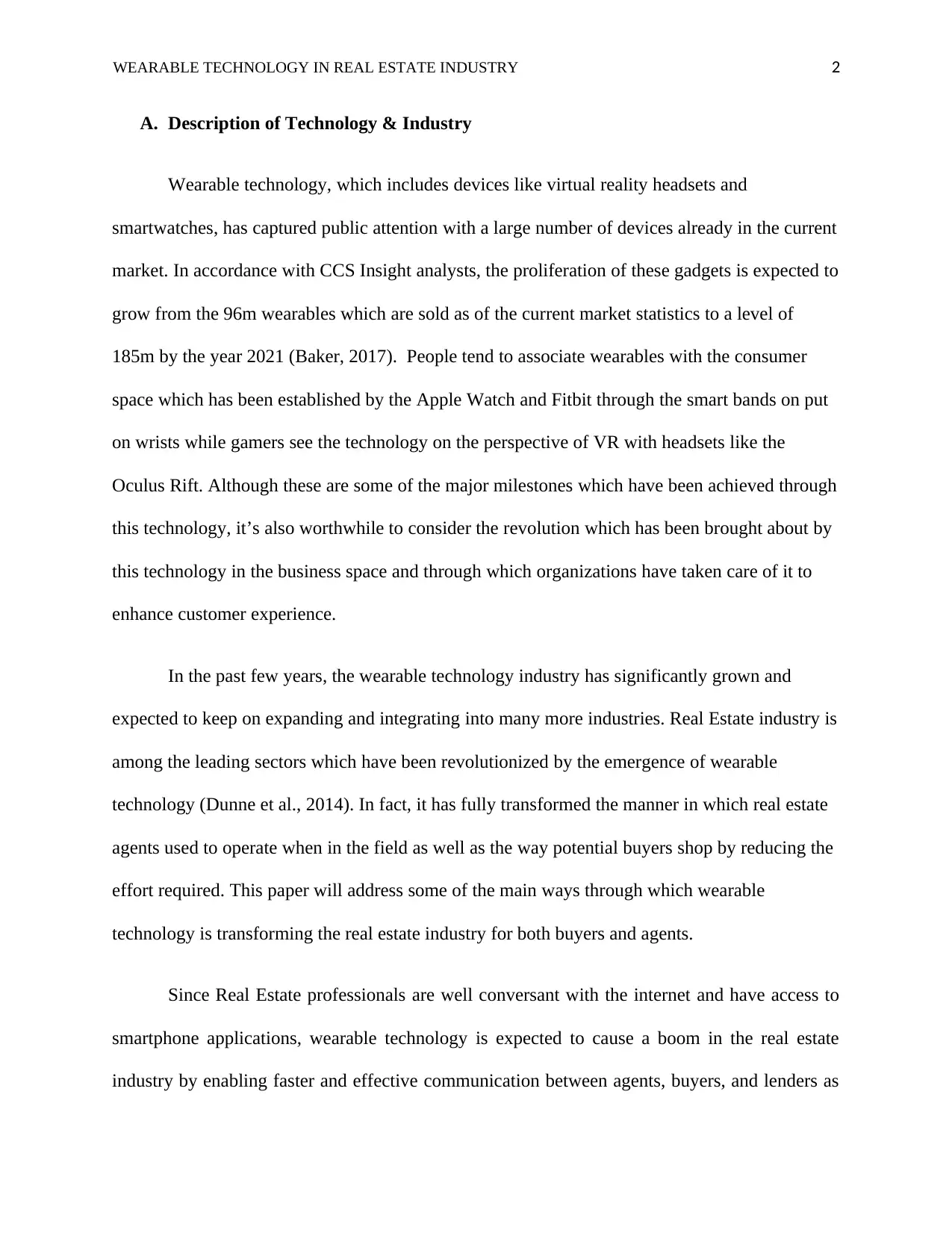
WEARABLE TECHNOLOGY IN REAL ESTATE INDUSTRY 2
A. Description of Technology & Industry
Wearable technology, which includes devices like virtual reality headsets and
smartwatches, has captured public attention with a large number of devices already in the current
market. In accordance with CCS Insight analysts, the proliferation of these gadgets is expected to
grow from the 96m wearables which are sold as of the current market statistics to a level of
185m by the year 2021 (Baker, 2017). People tend to associate wearables with the consumer
space which has been established by the Apple Watch and Fitbit through the smart bands on put
on wrists while gamers see the technology on the perspective of VR with headsets like the
Oculus Rift. Although these are some of the major milestones which have been achieved through
this technology, it’s also worthwhile to consider the revolution which has been brought about by
this technology in the business space and through which organizations have taken care of it to
enhance customer experience.
In the past few years, the wearable technology industry has significantly grown and
expected to keep on expanding and integrating into many more industries. Real Estate industry is
among the leading sectors which have been revolutionized by the emergence of wearable
technology (Dunne et al., 2014). In fact, it has fully transformed the manner in which real estate
agents used to operate when in the field as well as the way potential buyers shop by reducing the
effort required. This paper will address some of the main ways through which wearable
technology is transforming the real estate industry for both buyers and agents.
Since Real Estate professionals are well conversant with the internet and have access to
smartphone applications, wearable technology is expected to cause a boom in the real estate
industry by enabling faster and effective communication between agents, buyers, and lenders as
A. Description of Technology & Industry
Wearable technology, which includes devices like virtual reality headsets and
smartwatches, has captured public attention with a large number of devices already in the current
market. In accordance with CCS Insight analysts, the proliferation of these gadgets is expected to
grow from the 96m wearables which are sold as of the current market statistics to a level of
185m by the year 2021 (Baker, 2017). People tend to associate wearables with the consumer
space which has been established by the Apple Watch and Fitbit through the smart bands on put
on wrists while gamers see the technology on the perspective of VR with headsets like the
Oculus Rift. Although these are some of the major milestones which have been achieved through
this technology, it’s also worthwhile to consider the revolution which has been brought about by
this technology in the business space and through which organizations have taken care of it to
enhance customer experience.
In the past few years, the wearable technology industry has significantly grown and
expected to keep on expanding and integrating into many more industries. Real Estate industry is
among the leading sectors which have been revolutionized by the emergence of wearable
technology (Dunne et al., 2014). In fact, it has fully transformed the manner in which real estate
agents used to operate when in the field as well as the way potential buyers shop by reducing the
effort required. This paper will address some of the main ways through which wearable
technology is transforming the real estate industry for both buyers and agents.
Since Real Estate professionals are well conversant with the internet and have access to
smartphone applications, wearable technology is expected to cause a boom in the real estate
industry by enabling faster and effective communication between agents, buyers, and lenders as
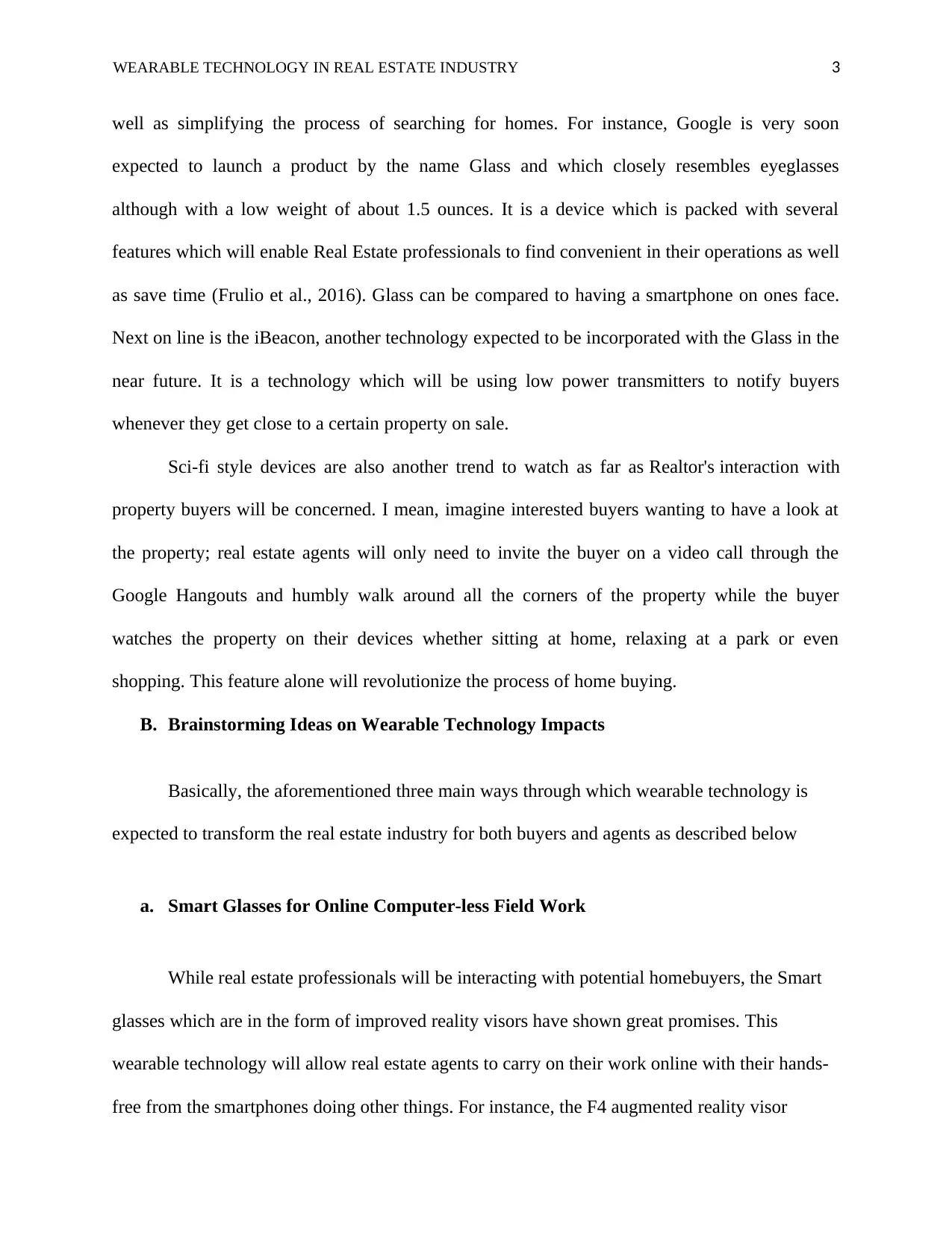
WEARABLE TECHNOLOGY IN REAL ESTATE INDUSTRY 3
well as simplifying the process of searching for homes. For instance, Google is very soon
expected to launch a product by the name Glass and which closely resembles eyeglasses
although with a low weight of about 1.5 ounces. It is a device which is packed with several
features which will enable Real Estate professionals to find convenient in their operations as well
as save time (Frulio et al., 2016). Glass can be compared to having a smartphone on ones face.
Next on line is the iBeacon, another technology expected to be incorporated with the Glass in the
near future. It is a technology which will be using low power transmitters to notify buyers
whenever they get close to a certain property on sale.
Sci-fi style devices are also another trend to watch as far as Realtor's interaction with
property buyers will be concerned. I mean, imagine interested buyers wanting to have a look at
the property; real estate agents will only need to invite the buyer on a video call through the
Google Hangouts and humbly walk around all the corners of the property while the buyer
watches the property on their devices whether sitting at home, relaxing at a park or even
shopping. This feature alone will revolutionize the process of home buying.
B. Brainstorming Ideas on Wearable Technology Impacts
Basically, the aforementioned three main ways through which wearable technology is
expected to transform the real estate industry for both buyers and agents as described below
a. Smart Glasses for Online Computer-less Field Work
While real estate professionals will be interacting with potential homebuyers, the Smart
glasses which are in the form of improved reality visors have shown great promises. This
wearable technology will allow real estate agents to carry on their work online with their hands-
free from the smartphones doing other things. For instance, the F4 augmented reality visor
well as simplifying the process of searching for homes. For instance, Google is very soon
expected to launch a product by the name Glass and which closely resembles eyeglasses
although with a low weight of about 1.5 ounces. It is a device which is packed with several
features which will enable Real Estate professionals to find convenient in their operations as well
as save time (Frulio et al., 2016). Glass can be compared to having a smartphone on ones face.
Next on line is the iBeacon, another technology expected to be incorporated with the Glass in the
near future. It is a technology which will be using low power transmitters to notify buyers
whenever they get close to a certain property on sale.
Sci-fi style devices are also another trend to watch as far as Realtor's interaction with
property buyers will be concerned. I mean, imagine interested buyers wanting to have a look at
the property; real estate agents will only need to invite the buyer on a video call through the
Google Hangouts and humbly walk around all the corners of the property while the buyer
watches the property on their devices whether sitting at home, relaxing at a park or even
shopping. This feature alone will revolutionize the process of home buying.
B. Brainstorming Ideas on Wearable Technology Impacts
Basically, the aforementioned three main ways through which wearable technology is
expected to transform the real estate industry for both buyers and agents as described below
a. Smart Glasses for Online Computer-less Field Work
While real estate professionals will be interacting with potential homebuyers, the Smart
glasses which are in the form of improved reality visors have shown great promises. This
wearable technology will allow real estate agents to carry on their work online with their hands-
free from the smartphones doing other things. For instance, the F4 augmented reality visor
⊘ This is a preview!⊘
Do you want full access?
Subscribe today to unlock all pages.

Trusted by 1+ million students worldwide
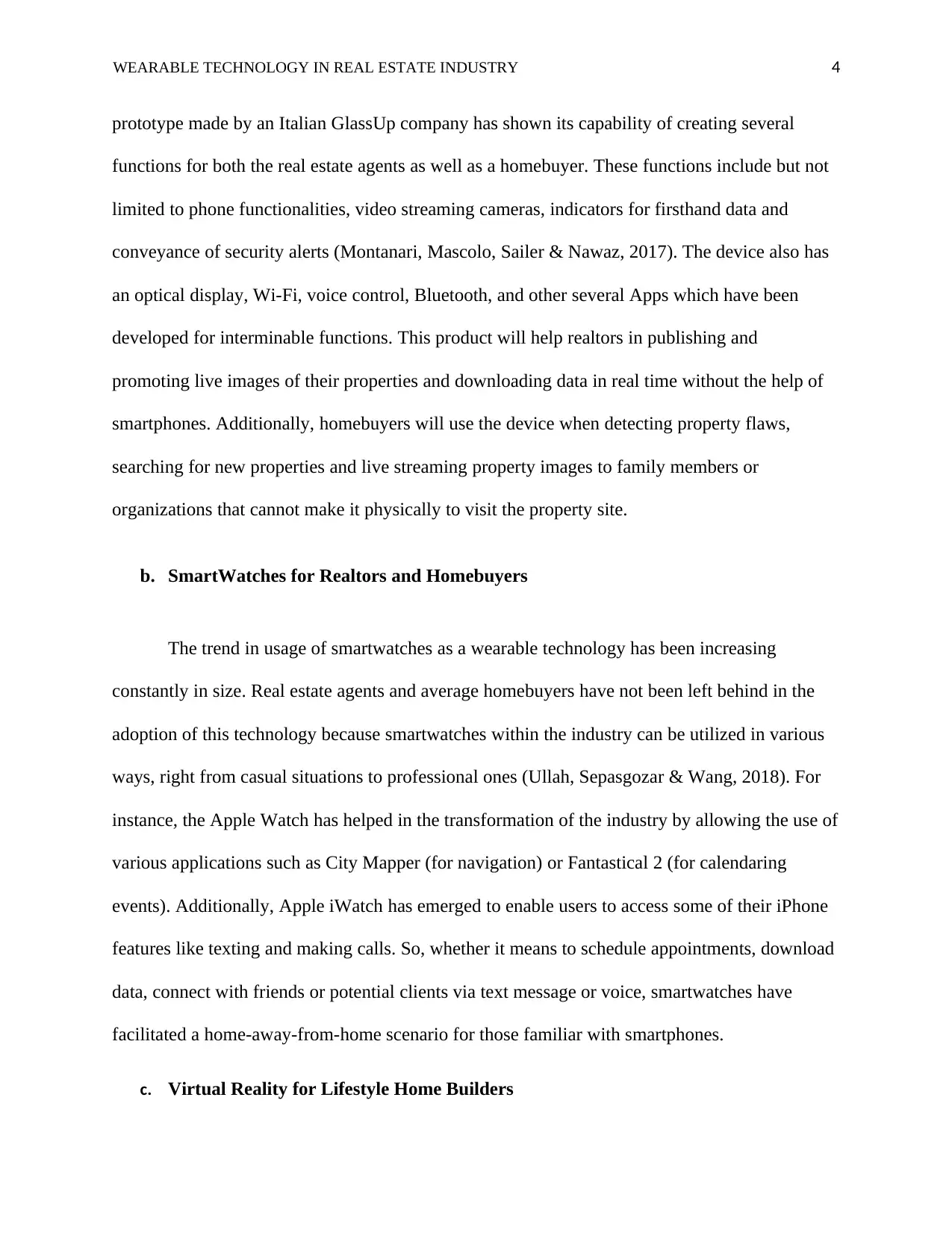
WEARABLE TECHNOLOGY IN REAL ESTATE INDUSTRY 4
prototype made by an Italian GlassUp company has shown its capability of creating several
functions for both the real estate agents as well as a homebuyer. These functions include but not
limited to phone functionalities, video streaming cameras, indicators for firsthand data and
conveyance of security alerts (Montanari, Mascolo, Sailer & Nawaz, 2017). The device also has
an optical display, Wi-Fi, voice control, Bluetooth, and other several Apps which have been
developed for interminable functions. This product will help realtors in publishing and
promoting live images of their properties and downloading data in real time without the help of
smartphones. Additionally, homebuyers will use the device when detecting property flaws,
searching for new properties and live streaming property images to family members or
organizations that cannot make it physically to visit the property site.
b. SmartWatches for Realtors and Homebuyers
The trend in usage of smartwatches as a wearable technology has been increasing
constantly in size. Real estate agents and average homebuyers have not been left behind in the
adoption of this technology because smartwatches within the industry can be utilized in various
ways, right from casual situations to professional ones (Ullah, Sepasgozar & Wang, 2018). For
instance, the Apple Watch has helped in the transformation of the industry by allowing the use of
various applications such as City Mapper (for navigation) or Fantastical 2 (for calendaring
events). Additionally, Apple iWatch has emerged to enable users to access some of their iPhone
features like texting and making calls. So, whether it means to schedule appointments, download
data, connect with friends or potential clients via text message or voice, smartwatches have
facilitated a home-away-from-home scenario for those familiar with smartphones.
c. Virtual Reality for Lifestyle Home Builders
prototype made by an Italian GlassUp company has shown its capability of creating several
functions for both the real estate agents as well as a homebuyer. These functions include but not
limited to phone functionalities, video streaming cameras, indicators for firsthand data and
conveyance of security alerts (Montanari, Mascolo, Sailer & Nawaz, 2017). The device also has
an optical display, Wi-Fi, voice control, Bluetooth, and other several Apps which have been
developed for interminable functions. This product will help realtors in publishing and
promoting live images of their properties and downloading data in real time without the help of
smartphones. Additionally, homebuyers will use the device when detecting property flaws,
searching for new properties and live streaming property images to family members or
organizations that cannot make it physically to visit the property site.
b. SmartWatches for Realtors and Homebuyers
The trend in usage of smartwatches as a wearable technology has been increasing
constantly in size. Real estate agents and average homebuyers have not been left behind in the
adoption of this technology because smartwatches within the industry can be utilized in various
ways, right from casual situations to professional ones (Ullah, Sepasgozar & Wang, 2018). For
instance, the Apple Watch has helped in the transformation of the industry by allowing the use of
various applications such as City Mapper (for navigation) or Fantastical 2 (for calendaring
events). Additionally, Apple iWatch has emerged to enable users to access some of their iPhone
features like texting and making calls. So, whether it means to schedule appointments, download
data, connect with friends or potential clients via text message or voice, smartwatches have
facilitated a home-away-from-home scenario for those familiar with smartphones.
c. Virtual Reality for Lifestyle Home Builders
Paraphrase This Document
Need a fresh take? Get an instant paraphrase of this document with our AI Paraphraser
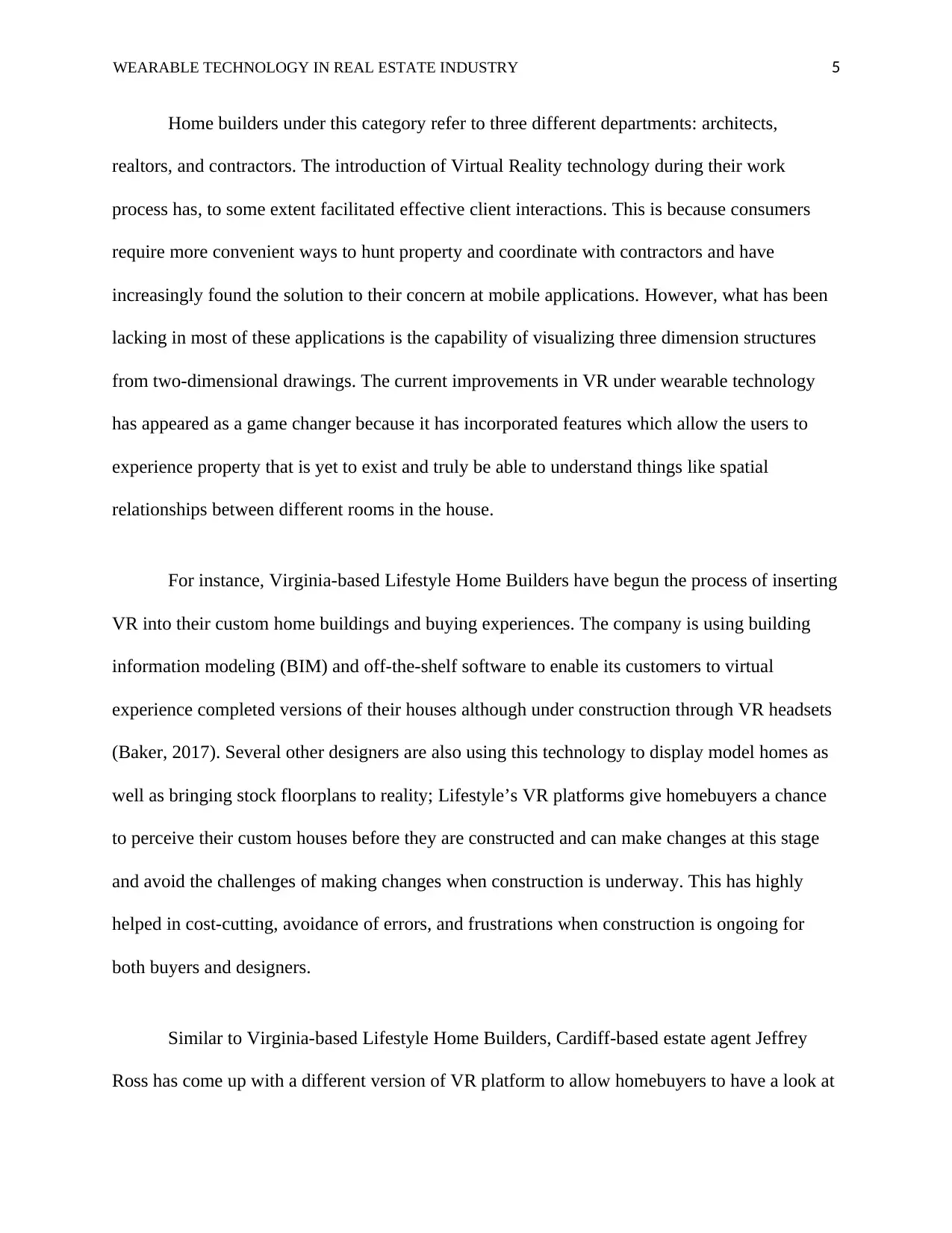
WEARABLE TECHNOLOGY IN REAL ESTATE INDUSTRY 5
Home builders under this category refer to three different departments: architects,
realtors, and contractors. The introduction of Virtual Reality technology during their work
process has, to some extent facilitated effective client interactions. This is because consumers
require more convenient ways to hunt property and coordinate with contractors and have
increasingly found the solution to their concern at mobile applications. However, what has been
lacking in most of these applications is the capability of visualizing three dimension structures
from two-dimensional drawings. The current improvements in VR under wearable technology
has appeared as a game changer because it has incorporated features which allow the users to
experience property that is yet to exist and truly be able to understand things like spatial
relationships between different rooms in the house.
For instance, Virginia-based Lifestyle Home Builders have begun the process of inserting
VR into their custom home buildings and buying experiences. The company is using building
information modeling (BIM) and off-the-shelf software to enable its customers to virtual
experience completed versions of their houses although under construction through VR headsets
(Baker, 2017). Several other designers are also using this technology to display model homes as
well as bringing stock floorplans to reality; Lifestyle’s VR platforms give homebuyers a chance
to perceive their custom houses before they are constructed and can make changes at this stage
and avoid the challenges of making changes when construction is underway. This has highly
helped in cost-cutting, avoidance of errors, and frustrations when construction is ongoing for
both buyers and designers.
Similar to Virginia-based Lifestyle Home Builders, Cardiff-based estate agent Jeffrey
Ross has come up with a different version of VR platform to allow homebuyers to have a look at
Home builders under this category refer to three different departments: architects,
realtors, and contractors. The introduction of Virtual Reality technology during their work
process has, to some extent facilitated effective client interactions. This is because consumers
require more convenient ways to hunt property and coordinate with contractors and have
increasingly found the solution to their concern at mobile applications. However, what has been
lacking in most of these applications is the capability of visualizing three dimension structures
from two-dimensional drawings. The current improvements in VR under wearable technology
has appeared as a game changer because it has incorporated features which allow the users to
experience property that is yet to exist and truly be able to understand things like spatial
relationships between different rooms in the house.
For instance, Virginia-based Lifestyle Home Builders have begun the process of inserting
VR into their custom home buildings and buying experiences. The company is using building
information modeling (BIM) and off-the-shelf software to enable its customers to virtual
experience completed versions of their houses although under construction through VR headsets
(Baker, 2017). Several other designers are also using this technology to display model homes as
well as bringing stock floorplans to reality; Lifestyle’s VR platforms give homebuyers a chance
to perceive their custom houses before they are constructed and can make changes at this stage
and avoid the challenges of making changes when construction is underway. This has highly
helped in cost-cutting, avoidance of errors, and frustrations when construction is ongoing for
both buyers and designers.
Similar to Virginia-based Lifestyle Home Builders, Cardiff-based estate agent Jeffrey
Ross has come up with a different version of VR platform to allow homebuyers to have a look at
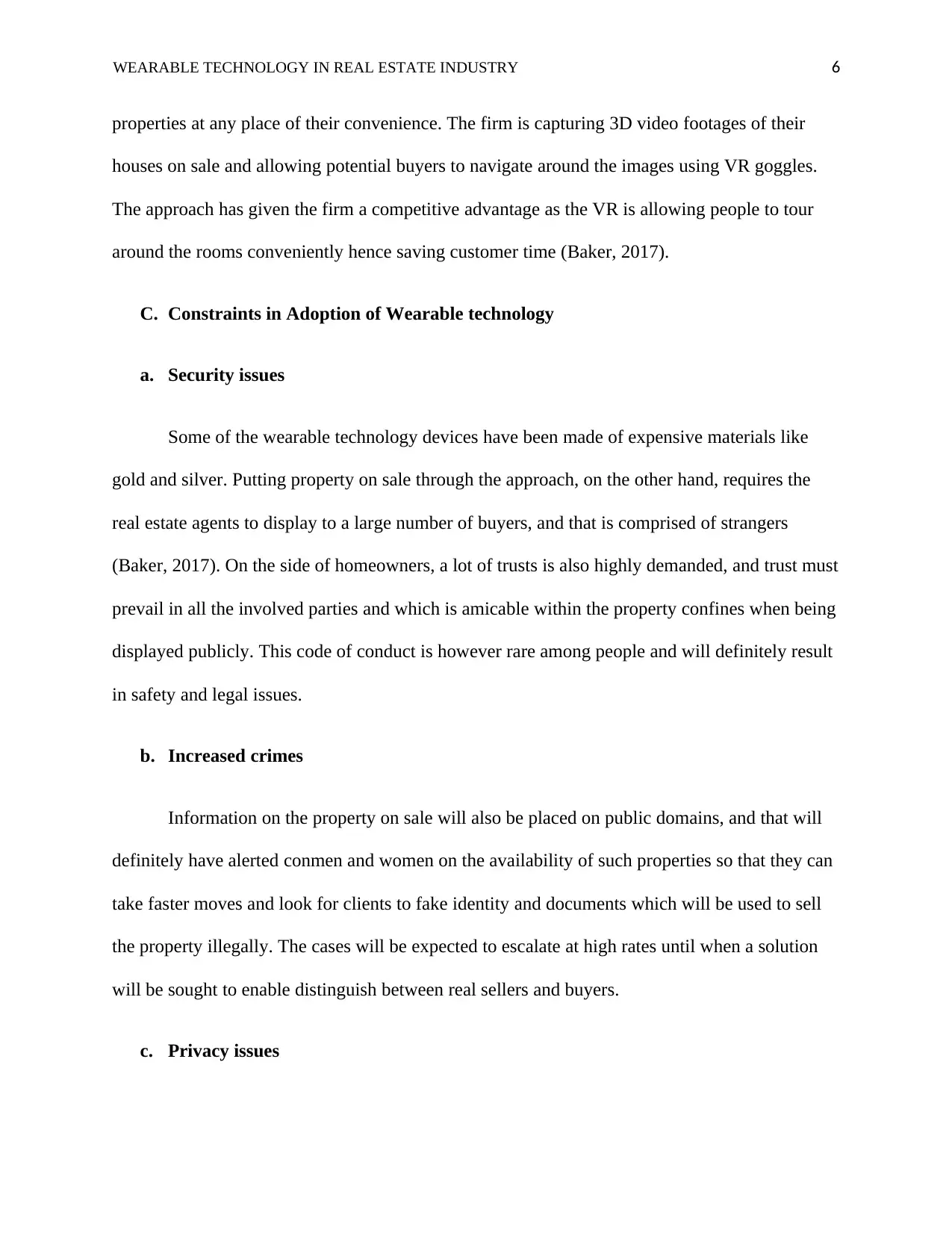
WEARABLE TECHNOLOGY IN REAL ESTATE INDUSTRY 6
properties at any place of their convenience. The firm is capturing 3D video footages of their
houses on sale and allowing potential buyers to navigate around the images using VR goggles.
The approach has given the firm a competitive advantage as the VR is allowing people to tour
around the rooms conveniently hence saving customer time (Baker, 2017).
C. Constraints in Adoption of Wearable technology
a. Security issues
Some of the wearable technology devices have been made of expensive materials like
gold and silver. Putting property on sale through the approach, on the other hand, requires the
real estate agents to display to a large number of buyers, and that is comprised of strangers
(Baker, 2017). On the side of homeowners, a lot of trusts is also highly demanded, and trust must
prevail in all the involved parties and which is amicable within the property confines when being
displayed publicly. This code of conduct is however rare among people and will definitely result
in safety and legal issues.
b. Increased crimes
Information on the property on sale will also be placed on public domains, and that will
definitely have alerted conmen and women on the availability of such properties so that they can
take faster moves and look for clients to fake identity and documents which will be used to sell
the property illegally. The cases will be expected to escalate at high rates until when a solution
will be sought to enable distinguish between real sellers and buyers.
c. Privacy issues
properties at any place of their convenience. The firm is capturing 3D video footages of their
houses on sale and allowing potential buyers to navigate around the images using VR goggles.
The approach has given the firm a competitive advantage as the VR is allowing people to tour
around the rooms conveniently hence saving customer time (Baker, 2017).
C. Constraints in Adoption of Wearable technology
a. Security issues
Some of the wearable technology devices have been made of expensive materials like
gold and silver. Putting property on sale through the approach, on the other hand, requires the
real estate agents to display to a large number of buyers, and that is comprised of strangers
(Baker, 2017). On the side of homeowners, a lot of trusts is also highly demanded, and trust must
prevail in all the involved parties and which is amicable within the property confines when being
displayed publicly. This code of conduct is however rare among people and will definitely result
in safety and legal issues.
b. Increased crimes
Information on the property on sale will also be placed on public domains, and that will
definitely have alerted conmen and women on the availability of such properties so that they can
take faster moves and look for clients to fake identity and documents which will be used to sell
the property illegally. The cases will be expected to escalate at high rates until when a solution
will be sought to enable distinguish between real sellers and buyers.
c. Privacy issues
⊘ This is a preview!⊘
Do you want full access?
Subscribe today to unlock all pages.

Trusted by 1+ million students worldwide
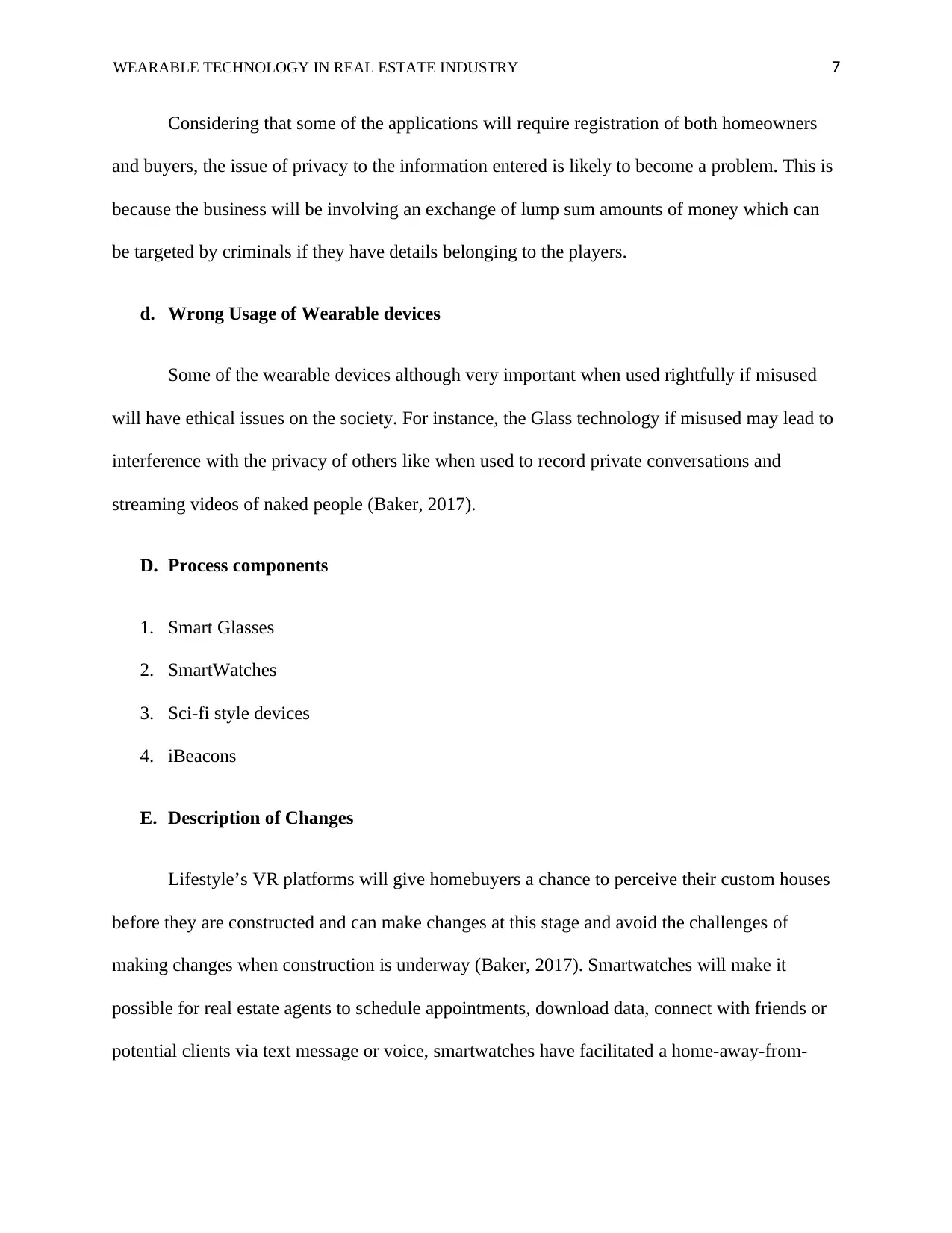
WEARABLE TECHNOLOGY IN REAL ESTATE INDUSTRY 7
Considering that some of the applications will require registration of both homeowners
and buyers, the issue of privacy to the information entered is likely to become a problem. This is
because the business will be involving an exchange of lump sum amounts of money which can
be targeted by criminals if they have details belonging to the players.
d. Wrong Usage of Wearable devices
Some of the wearable devices although very important when used rightfully if misused
will have ethical issues on the society. For instance, the Glass technology if misused may lead to
interference with the privacy of others like when used to record private conversations and
streaming videos of naked people (Baker, 2017).
D. Process components
1. Smart Glasses
2. SmartWatches
3. Sci-fi style devices
4. iBeacons
E. Description of Changes
Lifestyle’s VR platforms will give homebuyers a chance to perceive their custom houses
before they are constructed and can make changes at this stage and avoid the challenges of
making changes when construction is underway (Baker, 2017). Smartwatches will make it
possible for real estate agents to schedule appointments, download data, connect with friends or
potential clients via text message or voice, smartwatches have facilitated a home-away-from-
Considering that some of the applications will require registration of both homeowners
and buyers, the issue of privacy to the information entered is likely to become a problem. This is
because the business will be involving an exchange of lump sum amounts of money which can
be targeted by criminals if they have details belonging to the players.
d. Wrong Usage of Wearable devices
Some of the wearable devices although very important when used rightfully if misused
will have ethical issues on the society. For instance, the Glass technology if misused may lead to
interference with the privacy of others like when used to record private conversations and
streaming videos of naked people (Baker, 2017).
D. Process components
1. Smart Glasses
2. SmartWatches
3. Sci-fi style devices
4. iBeacons
E. Description of Changes
Lifestyle’s VR platforms will give homebuyers a chance to perceive their custom houses
before they are constructed and can make changes at this stage and avoid the challenges of
making changes when construction is underway (Baker, 2017). Smartwatches will make it
possible for real estate agents to schedule appointments, download data, connect with friends or
potential clients via text message or voice, smartwatches have facilitated a home-away-from-
Paraphrase This Document
Need a fresh take? Get an instant paraphrase of this document with our AI Paraphraser
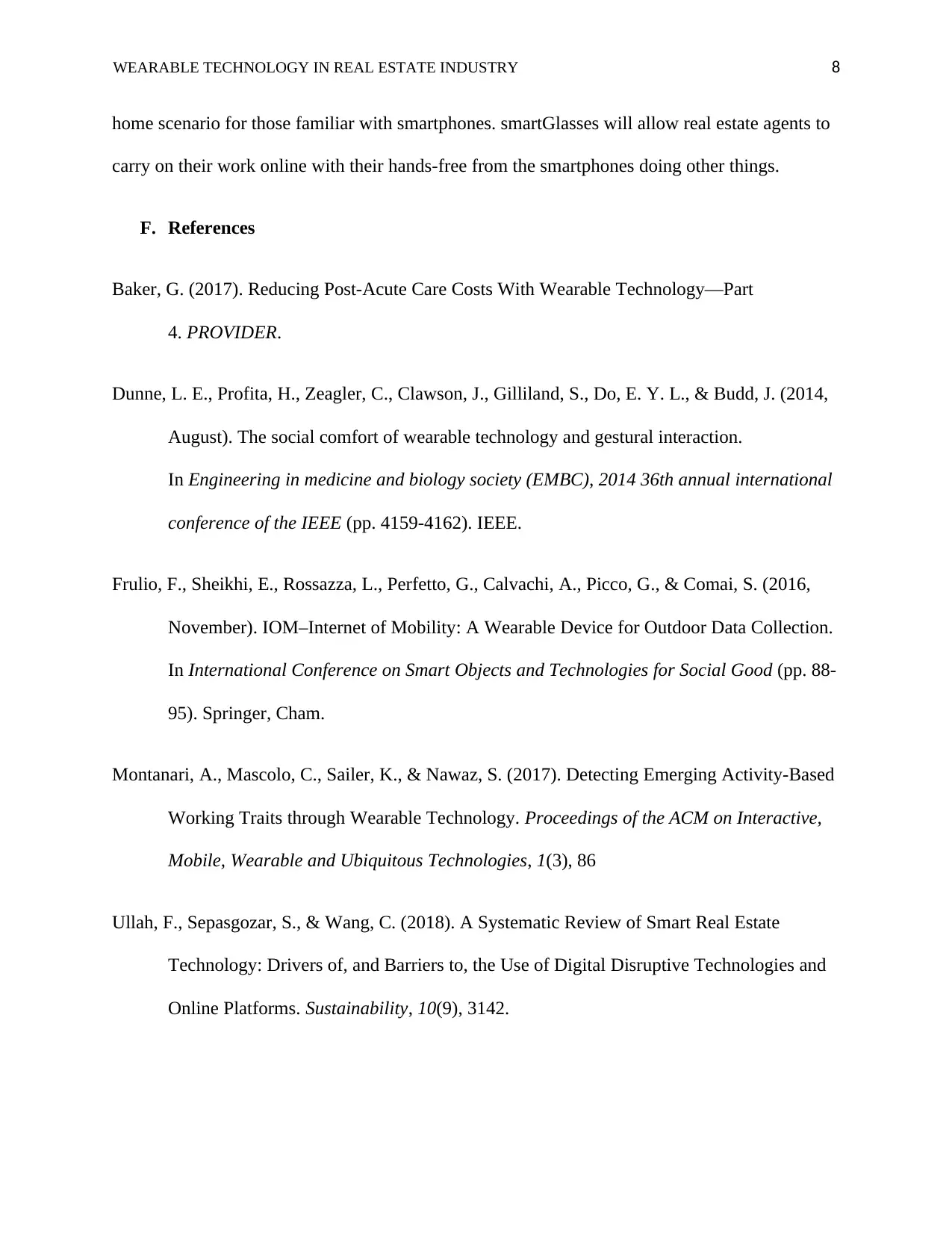
WEARABLE TECHNOLOGY IN REAL ESTATE INDUSTRY 8
home scenario for those familiar with smartphones. smartGlasses will allow real estate agents to
carry on their work online with their hands-free from the smartphones doing other things.
F. References
Baker, G. (2017). Reducing Post-Acute Care Costs With Wearable Technology—Part
4. PROVIDER.
Dunne, L. E., Profita, H., Zeagler, C., Clawson, J., Gilliland, S., Do, E. Y. L., & Budd, J. (2014,
August). The social comfort of wearable technology and gestural interaction.
In Engineering in medicine and biology society (EMBC), 2014 36th annual international
conference of the IEEE (pp. 4159-4162). IEEE.
Frulio, F., Sheikhi, E., Rossazza, L., Perfetto, G., Calvachi, A., Picco, G., & Comai, S. (2016,
November). IOM–Internet of Mobility: A Wearable Device for Outdoor Data Collection.
In International Conference on Smart Objects and Technologies for Social Good (pp. 88-
95). Springer, Cham.
Montanari, A., Mascolo, C., Sailer, K., & Nawaz, S. (2017). Detecting Emerging Activity-Based
Working Traits through Wearable Technology. Proceedings of the ACM on Interactive,
Mobile, Wearable and Ubiquitous Technologies, 1(3), 86
Ullah, F., Sepasgozar, S., & Wang, C. (2018). A Systematic Review of Smart Real Estate
Technology: Drivers of, and Barriers to, the Use of Digital Disruptive Technologies and
Online Platforms. Sustainability, 10(9), 3142.
home scenario for those familiar with smartphones. smartGlasses will allow real estate agents to
carry on their work online with their hands-free from the smartphones doing other things.
F. References
Baker, G. (2017). Reducing Post-Acute Care Costs With Wearable Technology—Part
4. PROVIDER.
Dunne, L. E., Profita, H., Zeagler, C., Clawson, J., Gilliland, S., Do, E. Y. L., & Budd, J. (2014,
August). The social comfort of wearable technology and gestural interaction.
In Engineering in medicine and biology society (EMBC), 2014 36th annual international
conference of the IEEE (pp. 4159-4162). IEEE.
Frulio, F., Sheikhi, E., Rossazza, L., Perfetto, G., Calvachi, A., Picco, G., & Comai, S. (2016,
November). IOM–Internet of Mobility: A Wearable Device for Outdoor Data Collection.
In International Conference on Smart Objects and Technologies for Social Good (pp. 88-
95). Springer, Cham.
Montanari, A., Mascolo, C., Sailer, K., & Nawaz, S. (2017). Detecting Emerging Activity-Based
Working Traits through Wearable Technology. Proceedings of the ACM on Interactive,
Mobile, Wearable and Ubiquitous Technologies, 1(3), 86
Ullah, F., Sepasgozar, S., & Wang, C. (2018). A Systematic Review of Smart Real Estate
Technology: Drivers of, and Barriers to, the Use of Digital Disruptive Technologies and
Online Platforms. Sustainability, 10(9), 3142.

WEARABLE TECHNOLOGY IN REAL ESTATE INDUSTRY 9
Warburton, D. (2016). The role of technology in the real estate industry (Doctoral dissertation,
University of Cape Town).
Warburton, D. (2016). The role of technology in the real estate industry (Doctoral dissertation,
University of Cape Town).
⊘ This is a preview!⊘
Do you want full access?
Subscribe today to unlock all pages.

Trusted by 1+ million students worldwide
1 out of 9
Related Documents
Your All-in-One AI-Powered Toolkit for Academic Success.
+13062052269
info@desklib.com
Available 24*7 on WhatsApp / Email
![[object Object]](/_next/static/media/star-bottom.7253800d.svg)
Unlock your academic potential
Copyright © 2020–2025 A2Z Services. All Rights Reserved. Developed and managed by ZUCOL.




